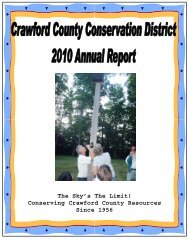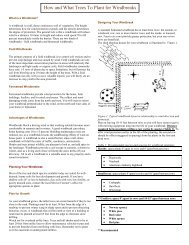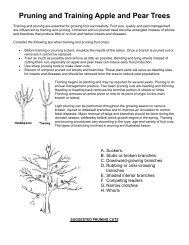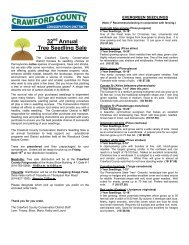Guidelines for Selling Your Timber - Crawford County Conservation ...
Guidelines for Selling Your Timber - Crawford County Conservation ...
Guidelines for Selling Your Timber - Crawford County Conservation ...
Create successful ePaper yourself
Turn your PDF publications into a flip-book with our unique Google optimized e-Paper software.
<strong>Guidelines</strong> <strong>for</strong> Marketing <strong>Your</strong> <strong>Timber</strong><strong>Timber</strong> is one of Pennsylvania’s renewable and most valuable resources. A properly managed andmaintained <strong>for</strong>est can remain healthy and productive from generation to generation. In Pennsylvania, it often takesbetween 80-120 years <strong>for</strong> a commercial, sawtimber-sized stand to develop. At some point, the harvesting of trees isusually essential <strong>for</strong> both financial and biological reasons. With sound planning, a timber harvest will not only benefityou financially but should benefit the health and sustainability of your <strong>for</strong>est!As a <strong>for</strong>estland owner, the burden is on YOU to plan <strong>for</strong> the health and productivity of your <strong>for</strong>est. Be<strong>for</strong>e anytree is even marked <strong>for</strong> harvest, it is essential <strong>for</strong> you to determine your goals and objectives <strong>for</strong> your property. Lookat your <strong>for</strong>est as a long-term investment, much like a retirement plan. When you retire you don’t “cash in” all yourmoney from your pension or retirement plan all at once; you make a plan on how to wisely manage your money so itwill last throughout your retirement years. Similarly, you should not “cash in” on your <strong>for</strong>est by cutting all the biggestand best trees <strong>for</strong> a one time monetary gain. If you decide to have timber harvested from your property it isimperative that you make sure sound, sustainable harvesting methods are practiced. A sustainable harvest not onlygenerates income today, but it retains or improves the overall health and value of your <strong>for</strong>est <strong>for</strong> the future.The best way to determine what you can do is to know what you have. Developing a <strong>for</strong>est managementplan can supply you with much of the necessary in<strong>for</strong>mation that you will need to make sound <strong>for</strong>est managementdecisions. There are several types of plans ranging from the structured and very detailed plans to the shorter, moreconcise plans; but all plans should contain: map(s), detailed descriptions (including history) and managementactivity prescriptions specific <strong>for</strong> your property. Only after a careful review and analysis of all the availablein<strong>for</strong>mation can you make a responsible decision to sell your timber. NEVER be pressured into selling your trees,Even in extreme cases of disease, insects, or salvage a timber sale should be a carefully though outdecision.When preparing <strong>for</strong> a timber sale, each tree that will be harvested should be marked, tallied and scaled <strong>for</strong>volume. Be<strong>for</strong>e selling, you should already have an impartial estimate of both the quantity and quality of the treesbeing sold. You are encouraged to hire a professional <strong>for</strong>ester to assist you in this process. It is important whenhiring a professional <strong>for</strong>ester to make sure they are able and willing to help you meet your goals. They should havethe experience to incorporate your goals into sound, sustainable <strong>for</strong>est management practices in your <strong>for</strong>est.Contact several <strong>for</strong>esters be<strong>for</strong>e making a final choice and then choose the professional who best understands andreflects your goals <strong>for</strong> your property. A professional <strong>for</strong>ester will focus on the trees that will be left in the stand, asmuch as those that will be harvested.High-grading is a practice that is occurring all too often in our Pennsylvania <strong>for</strong>ests. It refers to a practice ofremoving all the highest value (often largest) trees and leaving the lower value trees in the <strong>for</strong>est. This practicebiologically, economically and aesthetically degrades the <strong>for</strong>est <strong>for</strong> many, many years to come. It gives noconsideration <strong>for</strong> future regeneration, species composition, tree spacing or wildlife value. Proper <strong>for</strong>estmanagement involves looking at the age, spacing, species and size of all the trees and is not simply removing allthe “big” trees to make room <strong>for</strong> the “smaller” trees. High-grading is not only hard on the <strong>for</strong>est resources but it isnot a sustainable harvesting practice.Diameter limit cutting, or removing all trees over a certain diameter, is just as bad <strong>for</strong> the same reasons.Once the timber has been marked and the volume tallied, the professional <strong>for</strong>ester will generate a writtendocument called a prospectus. A timber sale prospectus should contain the following:1. Species, volume and log rule <strong>for</strong> the timber you are selling.2. Map and written location of the proposed timber sale.3. Tour date.4. Bid opening date.5. Any sale specifics (Roads, slash, seeding, machinery restrictions, etc.)
The prospectus should be mailed out to all potential buyers, several months in advance of the intended saledate. The sale is usually awarded to the highest bidder but the seller should always reserve the right to reject any orall bids. Since there is no one set price <strong>for</strong> standing timber, the competitive bid process is the only method that willensure that <strong>for</strong>est landowners get the maximum exposure and highest return <strong>for</strong> their <strong>for</strong>est products.Be<strong>for</strong>e any tree is cut, the landowner and the buyer should sign a written contractual agreement that clearlystates the responsibilities of all parties. A contract should at least contain the following:Name and address of parties within the contract.Date and location of contract signing.Location and legal description of the proposed sale.Description of the timber that is being sold.• This would include: number of trees by species, approximate volume by species,dollar value of species and the method of marking.Guarantee of timber ownership.Specific harvesting requirements.• Beginning and ending dates <strong>for</strong> cutting or other time limitations.• Shut–down specifications (i.e. <strong>for</strong> hunting season, wet conditions, etc.).• Requirements <strong>for</strong> stump heights and top lopping.• Cull tree requirements• Residual tree damage penalty clause.• Logging methods specifications.• Repair to existing roads or other damaged features.• Litter clean up.Erosion and Sedimentation (E & S) control.• E & S plan attached.• Avoidance or protection of springs, seeps and streams.• Obtaining all required permits covering stream crossings and wetland encroachments.• Use of best management practices.• Specify the post-harvest erosion control methods.Amount of bond and per<strong>for</strong>mance agreement.• This is payment over and above the selling price, held in escrow until sale termination,to ensure sale per<strong>for</strong>mance and adherence to the contract.Proof of current liability insurance from the buyer.Payment terms. Including rates <strong>for</strong> damage to residual trees.Liability protection from property damage and bodily injury.Requirements of buyer to abide by all local, state and federal laws and to obtain all necessary permits.Date of contract expiration.Forestry is never a risk-free venture but becoming well in<strong>for</strong>med on what you have and well educated on how tosell it will go a long way toward marketing your timber wisely and profitably. The Pennsylvania Bureau of Forestryhas field offices in almost every county in the state. The Bureau’s Service Foresters can offer advice on how to sellyour timber properly. They cannot, however, mark commercial timber sales <strong>for</strong> private landowners, except in rarecases due to extraordinary circumstances. Service Foresters can also provide in<strong>for</strong>mation on many other <strong>for</strong>estryrelatedtopics and can put you in touch with other <strong>for</strong>est landowners in your area, who are willing to share their<strong>for</strong>estry experiences. <strong>Your</strong> Service Forester is awaiting your call.Craw<strong>for</strong>d <strong>County</strong> 21742 German Road, Meadville, PA 16335 - (814) 763-2545Erie <strong>County</strong> 12723 Rt 19, Po Box 801, Water<strong>for</strong>d, PA 16441 – (814) 796-6787Forest/ Venango Co. 2 nd Floor, 484 Allegheny Blvd., Franklin, PA 16323 – (814) 437-3368Warren <strong>County</strong> 323 N. State St., N. Warren, PA 16365 – (814) 723-0262








